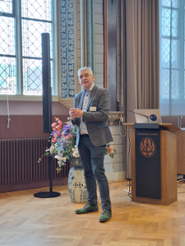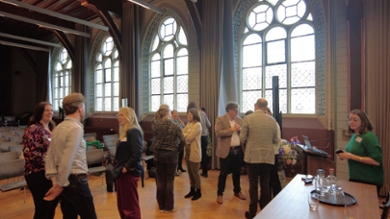
‘Maybe interdisciplinarity could function as a way to change the university’
image: Jan Joost Aten
This year, in a three-part symposium series, we are exploring how interdisciplinary collaboration can be promoted at the university. In the second session in March, the attendees discovered that understanding your rhythm and perspective is essential when embarking on an interdisciplinary project.
On the first warm spring day of the year, around 50 participants from within and outside the university couldn’t wait to get started at the Academy Building. Once again, the aim was to find ways to improve interdisciplinary collaboration.

Different rhythms
Paul Wouters, the former Dean of the Faculty of Social and Behavioural Sciences, opened the session. He spoke about interdisciplinary collaboration and different rhythms within the university. ‘Within the university, you have very different rhythms. For instance, fundamental research is very slow. Teaching, however, is more about short deadlines, such as having to hand in papers. Applied research for an external funder has yet another rhythm, as this type of work means you have different interactions with different external stakeholders.’
Join the conversation
Leiden University is working hard to create a robust interdisciplinary community where we learn from and help one another. Join the community and come to the third session in this trilogy on Thursday 6 June. This time we will be focusing on collaboration with public parties.
Obstacles and barriers to interdisciplinarity
Interdisciplinary work also has its own rhythm, said Wouters. ‘The proposition of interdisciplinary research is that if scientists from different disciplines come together, they can think about solutions for complex societal problems. But societal problems are not scientific problems. Therefore, a societal problem first has to be digested into a research framework.’
Wouters explained how Leiden’s interdisciplinary programmes have shown how you encounter all sorts of obstacles when starting an interdisciplinary project. These obstacles are caused by the different epistemic cultures, methods and methodologies of the researchers working on the project. Different institutes can also have different rhythms, for example in terms of criteria and the time assigned to teaching. ‘Interdisciplinarity is also very dependent on your collaboration skills’, he added.
‘Be honest’
Wouters then offered some tips. ‘We should be honest about the tensions and failures we experience in daily life. We are pretending too much, exploiting ourselves in the process. And it is very important to make time for interdisciplinary explorations and for people to fail.’ Questions were asked from the room about the role of management in learning about and valuing interdisciplinary work. Wouters concluded, ‘The upper level, the decision-makers, should be put in the “fire” of interdisciplinary research themselves.’ And he added a bit later: ‘Maybe interdisciplinarity could function as a way to change the university rather than society.’

Taking positions
In a sub-session, Corinne Lamain from the Centre for Unusual Collaborations (CuCo) spoke about CuCo’s work promoting interdisciplinary collaboration. Skills researchers definitely need for such collaborations are a disciplinary grounding (basic knowledge of all the disciplines that are involved in a certain project), perspective taking and finding common ground and integration. Lamain then got the attendees to do an exercise in disciplinary grounding. Based on statements or questions (such as: ‘Is reality objectively observable?’), those present had to take up a position on the floor. They then had to listen to why others had taken their position. Laiman effectively showed that the position you take is really important when starting a collaboration. Because subtle differences in opinions sometimes caused a metre’s distance between the participants.

Come up with your own teaching programme
Johanna Colgrove (Technical Physics, Delft) and Hegias Bontebal (Erasmus MC) took the participants through the development of an interdisciplinary teaching programme. Based on their experiences in developing a minor “Collaborative Science for Biomedical Breakthroughs”, they interactively challenged the attendees to come up with a fictional teaching programme in less than an hour based on different disciplines. Colgrove and Bontebal instructed those present to approach one another with curiosity and to look for a common denominator with themes where there seems to be little overlap. They also spoke about their experiences developing the minor. They explained how important it is to organise your own feedback so you can continually learn and improve. And actively making space to learn from one another’s disciplinary perspectives, ideas about teaching and knowledge of the subject is another important factor in getting interdisciplinary teaching off the ground.
The third and final symposium in this trilogy on interdisciplinary work will be held on Thursday, June 6, 15.00-17.00. Sign up now!
